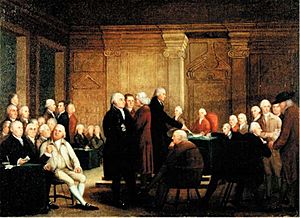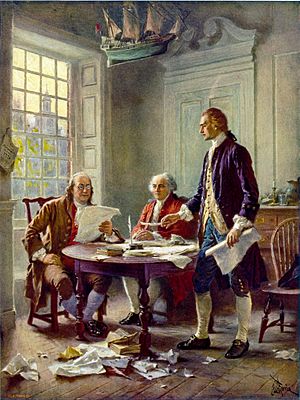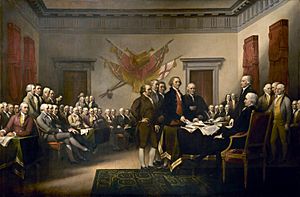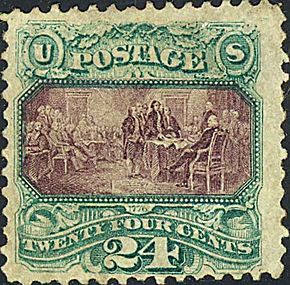Committee of Five facts for kids


The Committee of Five was a special group of five people from the Second Continental Congress. Their job was to write the first version of what would become the United States Declaration of Independence. This very important document was officially adopted on July 4, 1776. This committee worked from June 11, 1776, until July 5, 1776, which was the day the Declaration was made public.
The five members of this committee were John Adams, Benjamin Franklin, Thomas Jefferson, Robert Livingston, and Roger Sherman.
Contents
Who Was in the Committee of Five?
This important group included:
- John Adams, who represented Massachusetts. He later became the second president of the United States.
- Thomas Jefferson, who represented Virginia. He later became the third president.
- Benjamin Franklin, who represented Pennsylvania. He was a very famous thinker and writer among the Founding Fathers. His ideas and writings greatly influenced the American Revolution.
- Roger Sherman, who represented Connecticut. He is the only person who signed all four major U.S. founding documents: the Continental Association, the Declaration of Independence, the Articles of Confederation, and the U.S. Constitution.
- Robert Livingston, who represented New York. He later became the first U.S. Secretary of Foreign Affairs. He also gave the presidential oath to George Washington and helped with the Louisiana Purchase when he was a minister in France.
How the Declaration of Independence Was Written


The representatives from the Thirteen Colonies in Congress decided to wait until July 1 to make a final decision about declaring their independence. This idea, called the Lee Resolution, was first suggested on June 7 by Richard Henry Lee from Virginia. During the three weeks they waited, Congress decided to create a committee. This committee would write a statement to explain to the world why the Colonies were separating from the British Empire.
On June 11, the Committee of Five was chosen. It included John Adams (Massachusetts), Roger Sherman (Connecticut), Robert Livingston (New York), Benjamin Franklin (Pennsylvania), and Thomas Jefferson (Virginia). We don't have exact notes from their meetings, so we're not entirely sure how they wrote the document.
The First Draft
After talking about what the document should generally say, the committee decided that Thomas Jefferson would write the first draft. He had about 17 days to do this, even though Congress was very busy. After he wrote it, he shared it with the other committee members. They reviewed his draft and made many changes. Jefferson then wrote a new version with all these changes included.
One important change was making the phrase "preservation of life, & liberty, & the pursuit of happiness" shorter and more famous: "Life, Liberty and the pursuit of Happiness." This idea is similar to, but different from, John Locke's idea of "life, liberty, and estate" (which meant private property).
Jefferson's first draft also included strong criticism of Great Britain's use of slavery. However, this part was later removed. It was taken out to avoid upsetting people who owned enslaved people.
Presenting the Draft
On June 28, 1776, the committee showed their draft to the "Committee of the Whole" Congress. This moment is shown in John Trumbull's famous painting. The document's title was "A Declaration by the Representatives of the United States of America, in General Congress assembled."

Final Discussions
On July 2, the Congress officially declared the United Colonies to be independent. After this, the Committee of the Whole started to carefully review the exact words of the Declaration.
Last-Minute Changes
On July 3, the Committee of the Whole read the Declaration for a third time and looked closely at every word. They accepted most of the Committee of Five's draft. However, two parts were removed. One was a critical comment about the English people. The other was a strong statement against the slave trade and slavery itself.
Thomas Jefferson later wrote in his autobiography about why these two parts were removed:
Many people still hoped to stay friends with England. Because of this, the parts that criticized the people of England were taken out, so they wouldn't be offended. Also, the part that spoke against enslaving people from Africa was taken out to please South Carolina and Georgia. These states had never stopped bringing in enslaved people and wanted to continue doing so. Our Northern friends, I believe, also felt a bit sensitive about these criticisms. Even though their people had very few enslaved people themselves, they had been quite involved in bringing them to others.
The final changes to the text were mostly done by July 3. However, the official vote to adopt the Declaration happened the next morning, on July 4.
The Final Copy
After the Declaration was approved, it was sent back to the Committee of Five. Their job was to prepare a "fair copy." This was the final, corrected version ready to be sent to the printer, John Dunlap. So, the Committee of Five met on the evening of July 4 to finish this task.
Historians are not entirely sure who officially approved this final copy. It's unclear if the Committee of Five signed it, or if they gave it to President John Hancock to sign, or if Hancock signed the printed version. Either way, once the Dunlap broadside (the printed Declaration) was released on July 5, the Committee of Five's work was complete.
The Declaration Is Released
When the Dunlap broadside was released on July 5, the public could finally read who had signed the Declaration. John Hancock's signature, as the President of the Continental Congress, was on it. The Secretary of the Continental Congress, Charles Thomson, also signed it to confirm it was real. Over time, people's memories of exactly what happened on July 4 and 5, 1776, became a bit fuzzy. This led to the popular story that all the delegates signed the Declaration in one big ceremony on July 4, which isn't quite how it happened.
See also
 In Spanish: Comité de los Cinco para niños
In Spanish: Comité de los Cinco para niños
- Founding Fathers of the United States
- Committee of Detail, which helped write the U.S. Constitution



